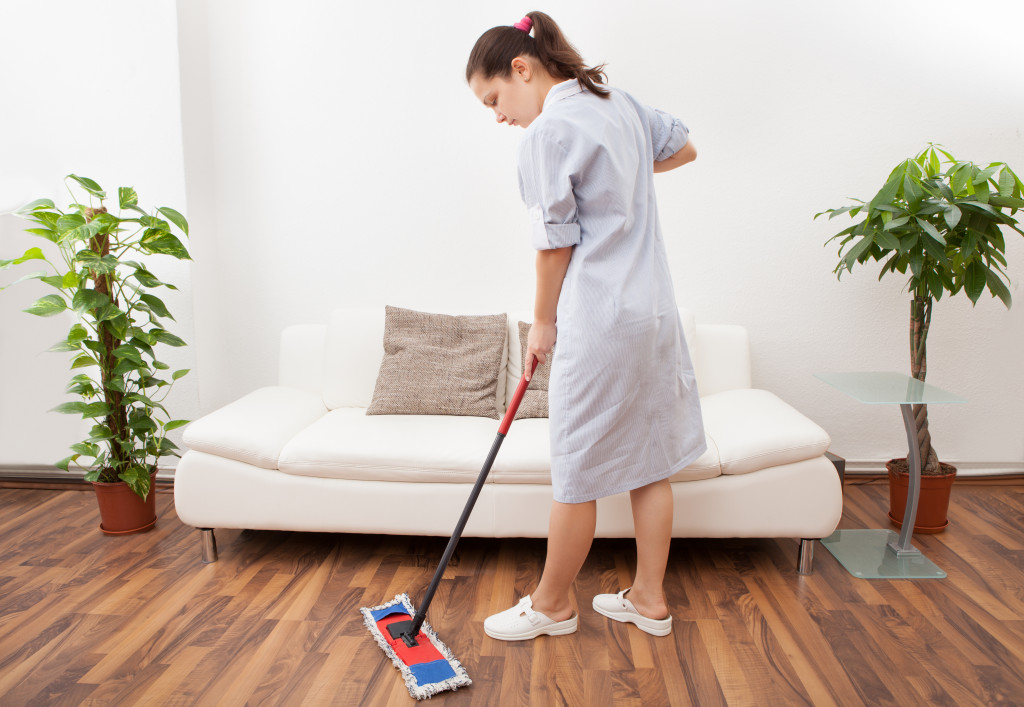Maintaining the condition of your home’s floors can seem like a never-ending battle. No matter how much you clean or take precautions, it feels like something always manages to happen, leaving them looking less than perfect. But don’t despair! With these five repair hacks, you’ll be able to keep your floors looking their best for years to come.
Hack #1: Cover Your Floors While You Paint
No matter how careful you are, paint splatters are inevitable when you’re painting. And if those paint splatters end up on your hardwood or laminate floors, they can be very difficult—not to mention costly—to remove. You can use the following:
Plastic Sheeting
Cover your floors with thin plastic sheets to protect them from paint drips. These are affordable, single-use, come in various sizes and shapes, and you can see through them–which is great if you need to cover a window but still let some light in. Just tape the sheeting down so it doesn’t move and create more of a mess than you started!
Newspaper
Newspapers provide the same level of protection as plastic sheets, but they’re often free if you ask local businesses. They have the advantage of being easily disposable, which is handy if you’re in a hurry. Just make sure to use thick pads of paper so the paint doesn’t bleed through, and check them frequently like you would with canvas.
Canvas
The canvas is an excellent cover for your flooring when you’re painting. Many skilled painters carry numerous huge pieces of heavy canvas to cover everything they need to shield, including floors. They are extremely safe because they aren’t slippery and can easily withstand significant foot traffic.
Canvas is not paint-proof but rather paint-resistant and almost infinitely reusable. They also happen to resist light splatter quite well. However, one thing to be aware of is that heavy spills can soak through the canvas material and stain rugs or floors beneath it. If you use canvas regularly, check underneath it often in case of unexpected spills.
Hack #2: Remove Scuff Marks with a Gum Eraser
Got scuff marks on your vinyl floor? No problem! Just grab a gum eraser and rub the marks gently until they disappear. The trick to minor repairing vinyl floors is using enough pressure to create friction, but not so much that you damage the floor. Just apply some pressure to the scuff mark and move the eraser back and forth until the mark is gone.
Scuffs may result from your pet’s nails, shoes, or other heavy things dragged across the floor, like furniture. Water might also accumulate beneath the floor and cause it to bubble up, making it more vulnerable to damage. To avoid water damage or mildew growth, thoroughly dry your vinyl floor following mopping. If the scuffs are too severe to be erased with an eraser, you’ll need to sand down the area and then reapply a new layer of wax or sealant.
Hack #3: Get Rid of Water Rings with Mayonnaise or Wax Paper
Water rings on wood furniture and floors are practically impossible to avoid, whether from glasses or hot pans. But instead of sanding down the entire table and starting from scratch, try this quick and easy hack: Rub mayonnaise or wax paper into the water ring until it disappears. It sounds too good to be true, but trust us—it works like a charm!
Removing water stains can be challenging, but using mayonnaise can be effective. The oil in mayo helps to remove moisture and cloudy residue. First, apply mayonnaise to the stain with a paper towel if you want to use this method. Let it sit for several hours or overnight, then wipe away the substance with a clean cloth. Finally, polish the area.
Wax paper, on the other hand, removes water rings because it repels moisture. To use this method, place wax paper over the stain and rub it back and forth until the ring disappears. Once the watermark is gone, wipe away any wax residue with a clean cloth.

Hack #4: Fix Loose Linoleum Tiles with Glue
Linoleum tiles tend to come loose over time, which can be both unsightly and dangerous. If you have loose linoleum tiles in your home, simply apply some glue to the back of the tile and press it firmly into place. The glue will hold the tile until it dries, which will be as good as new.
If you’re looking for eco-friendly adhesives to use during the installation or repairs of your linoleum tile floor, consider rye flour paste, cellulose glue, natural rubber glue, and natural resin glue. If VOCs (volatile organic compounds) are your main concern for indoor pollutants emitted from adhesives, purchase low or zero-VOC options.
You can use other types of adhesive for repairing linoleum floors, such as “linoleum adhesive” found at some stores. If you cannot find a product designed specifically for linoleum repair, look for flooring adhesives, such as wood glue (also called PVA glue), acrylate glue, and ethylene vinyl acetate glue (EVA glue).
Hack #5: Stop Squeaky Floors with Baby Powder
Nobody likes dealing with squeaky floors—especially in the middle of the night when you’re trying to get some sleep! But did you know that baby powder can help quiet squeaky floors? Simply sprinkle some baby powder into the cracks between your floorboards,, and the noise should immediately stop. Plus, this hack is completely safe for both children and pets.
This is only a short-term fix. The baby powder will eventually work its way out of the cracks, and the squeaks will return. If you’re looking for something more permanent, you’ll need to either screw or nail the floorboards down. However, the baby powder should do the trick if you want a quick fix!
Conclusion
Your home’s floors take a lot of abuse—but that doesn’t mean they have to look battered and beaten up. With these five simple hacks, you can keep your floors looking their best for years to come without spending a fortune on repairs or replacement materials. So what are you waiting for? Put these hacks to the test and see for yourself!

